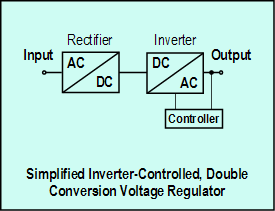Double Conversion Electronic Voltage Regulator Operation
 The double conversion electronic voltage regulator differs significantly in operation from the tap switching type EVR. The double conversion EVR uses a rectifier to convert AC power to DC and then uses an inverter to convert the DC power back to AC. Voltage regulation is obtained in one of two ways: 1) by regulating the DC voltage output from the rectifier, or 2) by supplying the inverter with a constant DC voltage and adjusting the voltage level during the conversion back to AC in the inverter. Method 1) can result in the lowest cost of components, and method 2) is most commonly used by uninterruptible power supplies (UPS). A UPS without batteries can be used as a voltage regulator, however it often provides less voltage regulating capability and higher cost than a true double conversion or tap switching electronic voltage regulator.
The double conversion electronic voltage regulator differs significantly in operation from the tap switching type EVR. The double conversion EVR uses a rectifier to convert AC power to DC and then uses an inverter to convert the DC power back to AC. Voltage regulation is obtained in one of two ways: 1) by regulating the DC voltage output from the rectifier, or 2) by supplying the inverter with a constant DC voltage and adjusting the voltage level during the conversion back to AC in the inverter. Method 1) can result in the lowest cost of components, and method 2) is most commonly used by uninterruptible power supplies (UPS). A UPS without batteries can be used as a voltage regulator, however it often provides less voltage regulating capability and higher cost than a true double conversion or tap switching electronic voltage regulator.
Like the full power semiconductor EVR, double conversion electronic voltage regulators have a very low tolerance to high load currents above the normal rating of the unit. Double conversion EVRs and UPS units are typically sized for the peak current load to avoid premature failure of the power semiconductors. These units may also require optional input and/or output transformers to get the desired input and output voltages and/or an isolated output.

